Must be under 23 on the 1st of January this current year and must produce a valid ID (e.g. passport) at the registration
Must be 50+ on the day of the show and and must produce a valid ID (e.g. passport) at the registration
| Men | Fitness | Performance | Athletic | Superbody | Extreme |
|---|---|---|---|---|---|
| Over 1.79m | < 80 kg | 80 -85 kg | 85 – 90 kg | 90 – 95 kg | > 95 kg |
| 1.72 m – 1.79m | < 75 kg | 75 – 80 kg | 80 – 85 kg | 85 – 90 kg | > 90 kg |
| 1.65 m – 1.72m | < 70 kg | 70 – 75 kg | 75 – 80 kg | 80 – 85 kg | > 85 kg |
| Under 1.65m | < 65 kg | 65 – 70 kg | 70 – 75 kg | 75 – 80 kg | > 80kg |
Front, Back And Sides Lineup
All competitors will present on stage in numerical order facing the judges. The head judge will call heels together facing the front. A series of quarter turns will follow. Competitors will be viewed from the left side, from the back, from the right side and from the front. Twisting is preferred on the left and right sides. Judging will be based on overall symmetry shape and muscle definition.
This discipline will require judges to evaluate standards of symmetry, proportion, muscular development and condition, posture and general deportment, in a RELAXED State.
Overall symmetry, muscular development and condition will be preferred to competitors with ´exceptional´ or ´sensational´ development areas which don´t come together in the form of overall symmetry or competitors with an imbalance in their physical make-up.
Competitors should remember this discipline in the first view the judges have of their physiques. By this stage all the serious training is over – so arguably posture and general deportment are the most important items on their list.
Individual Routines
This discipline will afford judges the opportunity to extend their assessment of individual Competitors.
The time allocation for each competitor will be 60 seconds (1 1/2 minutes) max.
In case of a high quantity of competitors the Chief Judge can decide for 1 minute posing time during the pre-judging.
Judges will be looking for tone, shape and quality of individual and collective muscle groups. Presentation will also be an important consideration, but the main criteria for selection and placing will be symmetry, proportion, muscular development and condition
Comparisons
Arguably the most important discipline of all. Eight compulsory comparisons poses which allow the judges to assess selected competitors against each other.
Compulsory comparisons poses are as follows:
Competitors will be judged on their masculine style, marketability and stage presence. Male Sports Models will also be judged on their ability to display their own unique character, style and self-confidence.
Male Fitness Models will be expected to show off their physical attributes that project a fit and healthy lifestyle; A LEAN, well-proportioned, toned and athletic looking body is the look that is wanted. Posing…hands OPEN NO BODYBUILDING POSES.
Men’s Sports Models are judged on the overall quality of their muscular development, personality and marketability. Judging is based equally upon the presentation of:
1. Shape
2. Muscularity
3. Condition
4. Stage Presence

Competition attire will consist of square cut spandex style swim shorts as the choice for Male Sports Model contestants. (NO swimming trunks or boxers/briefs) The current Men WFF SPORTS”MODEL” category is judged over two rounds Sports- theme and swimwear speedo or European style posing briefs for men.
Outfit : 1. European style posing briefs/shorts (square cut spandex style swim shorts or high cut style spandex shorts)
1. Shorts may be themed to a chosen sport
2. Sports shoes permitted
3. Sports equipment may be use as part of the theme chosen
Board Shorts, Swimming trunks and boxer/briefs will not be
permitted.

N.B. Wearing of Boardshorts will be disqualified.
Rounds: 3 Rounds of judging Round 1 Individual Ramp Walks (“T” or “V” walks) Round 2 4 x Quarter Turns Round 3 Comparison
To be completed by a “Pose Down” by all athletes

Round 1 – Individual Ramp Walks (T or V Walks)
Each athlete will be introduced individually as they enter from the rear of the stage and proceed to the rear centre of the stage. Depending on the number of athletes and the decision of the Head Judge and the organiser of the competition, the decision of either the “T” or “V” walk pattern will be followed on stage.
“T” Walk: The athlete to enter from the rear of the stage and proceed to the rear centre of the stage. The athlete will then “model” walk to the front of the stage, pause and pose. Then turn to the right and walk to the side of the stage (Front Right), pause and pose. Next, the athlete is to walk across the stage to the other side (Front Left), pause and pose before walking back to the centre of the stage (Front Centre). Here the athlete will pause, turn around and show her back to the judges before completing her final pose. The athlete will then walk back to the rear of the stage to join the rest of the athletes in the line-up.
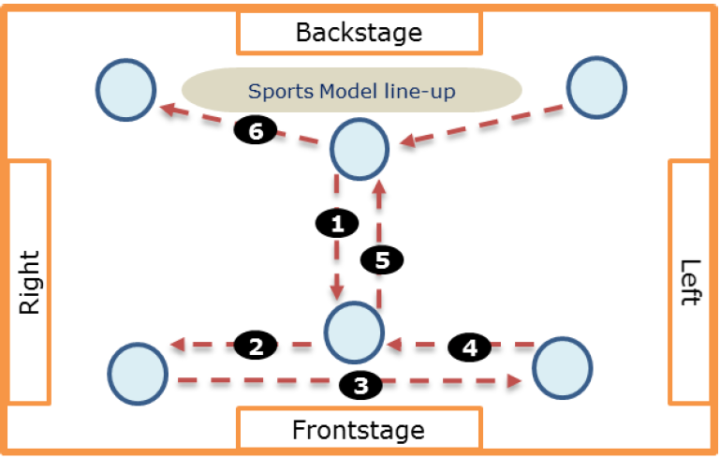
“V” Walk: Athlete to enter from the rear of the stage and proceed to the rear centre of the stage. Athlete will then “model” walk to the front of the stage (Front Centre) pause, pose and turn around and show her back to the judges before completing her final pose. The athlete will then walk back to the rear of the stage to join the rest of the athletes in the line-up.
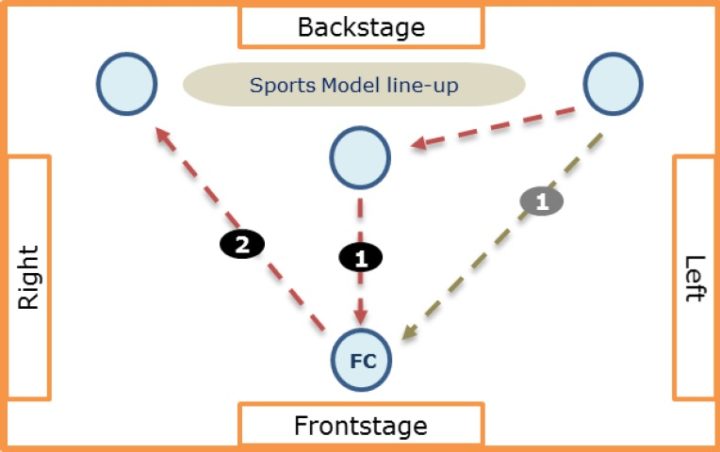
Round 2 – Quarters Turns (Front, Back & Side Line-Up’s)
This round will require judges to evaluate the symmetry, proportion, tone and shape without being excessively muscular and should be free from deep muscle separation and/or striations. Athletes to maintain poise, posture and general deportment, in a RELAXED State.
Athletes should remember this discipline is the first view the judges have of their physiques. By this stage all the serious training is over-soar guably muscle development of a sports athlete, lean v-tapered shape, balance and symmetry, condition, photogenic, marketability and stage presence are the most important items on their list.
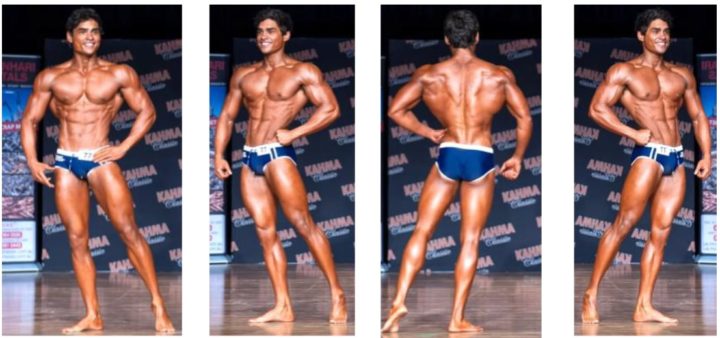
Round 3 – Comparison
This is the final round where the athlete has the opportunity to demonstrate their shape, poise and beauty to the judge. Judges will be making their final comparisons and assign a rank the athletes accordingly. Judges will assess the athlete from the front, back and also how they walk while showing case their model flair and overall poise and beauty. Athletes to “model” walk together in a line from the back to the front of the stage. They then pause, pose, turn around and model walk to the back of the stage. This walk will allow the Judges to compare from the front and also from the back.
After completion of the “model” walk, the athletes will collectively walk around the stage in a parade line and exit the stage.
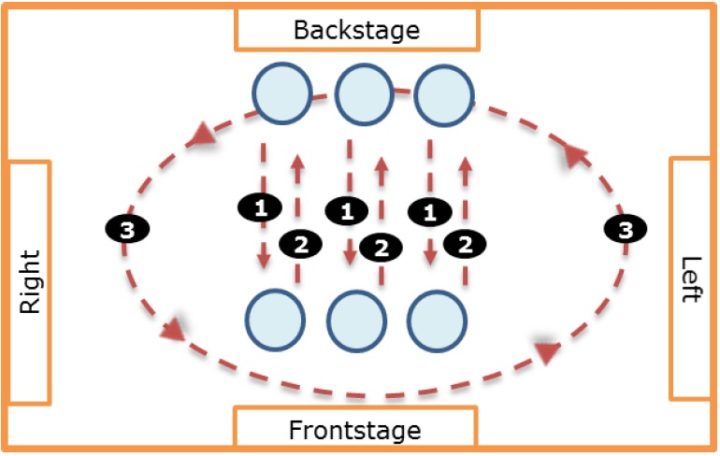
Classification within category;
The Bermuda /Beach Model athlete is judged similar to the male bodybuilder with the focus only on the upper body. The athlete in this category will have a good level of deep muscle separation and/or striations and vascularity but not as extreme as those found in men’s Bodybuilding athletes. The athlete will have a higher level of muscularity compared to the Sports Model but not more than a bodybuilder. The physique remains lean and athletic with wide shoulders that tapers down to a narrow waist and hips.
Bermuda / Beach Models athletes will also be judged on their masculine style, marketability and stage presence. The athletes will need to demonstrate their ability to display their own personality, style and self- confidence.
The 4 Criteria Judged:
Bermuda/Beach Model athletes are judged on the overall quality of their muscular development. Judging is based equally upon the presentation of:
1. Shape
2. Muscularity
3. Condition
4. Stage Presence
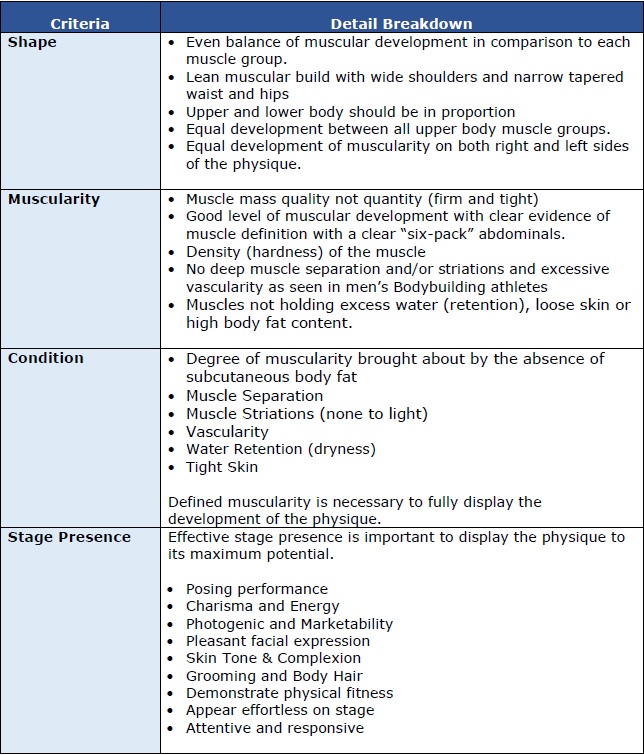
Outfit : 1. Bermuda shorts or Board shorts
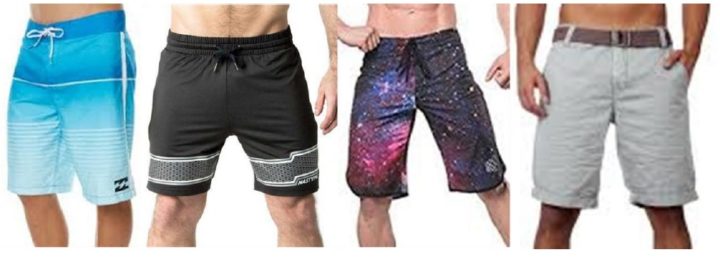
Rounds: 3 Rounds of judging

Round 1 – Individual Ramp Walks (T or V Walks)
Each athlete will be introduced individually as they enter from the rear of the stage and proceed to the rear centre of the stage. Depending on the number of athletes and the decision of the Head Judge and the organiser of the competition, the decision of either the “T” or “V” walk pattern will be followed on stage.
“T” Walk: The athlete to enter from the rear of the stage and proceed to the rear centre of the stage. The athlete will then “model” walk to the front of the stage, pause and pose. Then turn to the right and walk to the side of the stage (Front Right), pause and pose. Next, the athlete is to walk across the stage to the other side (Front Left), pause and pose before walking back to the centre of the stage (Front Centre). Here the athlete will pause, turn around and show her back to the judges before completing her final pose. The athlete will then walk back to the rear of the stage to join the rest of the athletes in the line-up.

“V” Walk: Athlete to enter from the rear of the stage and proceed to the rear centre of the stage. Athlete will then “model” walk to the front of the stage (Front Centre) pause, pose and turn around and show her back to the judges before completing her final pose. The athlete will then walk back to the rear of the stage to join the rest of the athletes in the line-up.

Round 2 – Quarters Turns (Front, Back & Side Line-Up’s)
This round will require judges to evaluate the symmetry, proportion, tone and shape without being excessively muscular and should be free from deep muscle separation and/or striations. Athletes to maintain poise, posture and general deportment, in a RELAXED State. Athletes should remember this discipline is the first view the judges have of their physiques. By this stage all the serious training is over-soar guablymuscular development, lean V tapered shape, balance and symmetry, condition, marketability and stage presence are the most important items on their list.
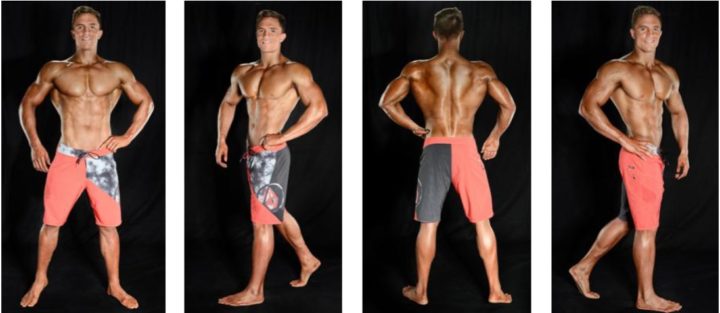
Round 3 – Comparison
This is the final round where the athlete has the opportunity to demonstrate their shape, poise and beauty to the judge. Judges will be making their final comparisons and assign a rank the athletes accordingly. Judges will assess the athlete from the front, back and also how they walk while showing case their model flair and overall poise and beauty. Athletes to “model” walk together in a line from the back to the front of the stage. They then pause, pose, turn around and model walk to the back of the stage. This walk will allow the Judges to compare from the front and also from the back.
After completion of the “model” walk, the athletes will collectively walk around the stage in a parade line and exit the stage

Athletes are reminded that extreme muscularity will be marked down.
Each athlete is introduced individually by number, name and country by MC and proceeds to follow a T Model walk on stage and creates a line at the rear of the stage.
Each Class is then introduced as a group onstage, in numerical order in a single line or two rows, depending on the volume of athletes.
In numerical order, each group is directed to the center-stage area facing the judges to perform the four quarter turns.
Quarter Turn Right b.Quarter Turn Rear c.Quarter Turn Right d.Quarter Turn Front
On completion of the quarter turns the group is reformed and directed to model cat-walk front and rear of stage for further judging comparison.
The line-up is further required to perform a circle or parade around the stage before final placings are awarded.
A pose down (no bodybuilding poses) is called to allow time for judging sheets to be collated.
Top three in each class are announced and requested to stand at rear of stage, the remaining athletes in the group are presented with commemorative medal and exit stage in a parade around the stage.
* If there are less than 4 athletes in any class the organiser may merge a class into the closest suitable class